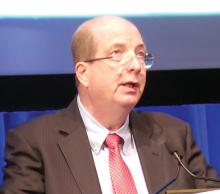The combination of the immune checkpoint inhibitor atezolizumab and bevacizumab has efficacy and tolerability superior to that of sunitinib alone as first-line therapy for metastatic renal cell carcinoma, finds the IMmotion151 trial.
“Sunitinib has been the reference standard for this disease for the last 10 years,” lead study author Robert J. Motzer, MD, of Memorial Sloan Kettering Cancer Center, New York, noted in a press briefing in advance of the 2018 Genitourinary Cancers Symposium. But strategies using immunotherapy have generated considerable excitement as possible new treatment options.
In the phase 3 trial, 915 patients with treatment-naive advanced or metastatic renal cell carcinoma were randomized evenly to two groups. One group received atezolizumab (Tecentriq), an antibody that targets programmed death ligand 1 (PD-L1), plus bevacizumab (Avastin), an antiangiogenic antibody. The other group received single-agent sunitinib (Sutent), a tyrosine kinase inhibitor having antiangiogenic and other actions.With a median follow-up of 15 months, compared with sunitinib, the combination of atezolizumab and bevacizumab prolonged investigator-assessed progression-free survival by 3.5 months among patients whose tumors were positive for PD-L1, defined as staining of at least 1% of tumor-infiltrating immune cells by immunohistochemistry. The difference translated to a 26% reduction in the risk of progression or death. However, the combination also had a significant edge in the trial population as a whole.
Overall survival and response rate likewise favored the combination of atezolizumab and bevacizumab. In addition, it was well tolerated, with a lower rate and severity of most adverse events. The exception was a higher rate of proteinuria, an established side effect of bevacizumab, with the combination.
“This trial met its primary endpoint,” Dr. Motzer concluded. “These study results support the consideration of atezolizumab plus bevacizumab as a first-line treatment option for PD-L1–positive patients with advanced renal cell carcinoma.”
Full results of IMmotion151 will be reported at the symposium, which runs Feb. 8-10 and is sponsored by the American Society of Clinical Oncology, ASTRO, and the Society of Urologic Oncology.
Findings in context
“This study represents an important breakthrough in kidney cancer therapy,” said Sumanta K. Pal, MD, presscast moderator and ASCO expert. “For several years now, we’ve hosted debates on which treatment strategy is best for this disease, targeted therapy or immune therapy. Now this study, which is really the first of its kind, points to a combination of both as being highly effective in delaying cancer growth and showing an early trend toward improving survival as well.”
It is also noteworthy that the combination has good tolerability that appears better in several respects to that seen with sunitinib, he said. “In my opinion, the side effect profile also compares favorably to what we have seen to date with a dual immunotherapy regimen, namely, nivolumab (Opdivo) and ipilimumab.” Although that combination has also been shown to be more efficacious than sunitinib, nearly 60% of treated patients need steroids for immune-related side effects, compared with only 16% treated with the atezolizumab-bevacizumab combination in IMmotion151.
“I would agree with Dr. Motzer that this data supports consideration of atezolizumab and bevacizumab as a first-line option,” concluded Dr. Pal, codirector of the Kidney Cancer Program at City of Hope, Duarte, Calif. “I was intrigued to see that there seemed to be benefit with the combination of atezolizumab and bevacizumab irrespective of the presence or absence of PD-L1.”
Study details
About 40% of patients in IMmotion151 had PD-L1–positive tumors. Median investigator-assessed progression-free survival among these patients, a co-primary endpoint, was 11.2 months with atezolizumab-bevacizumab and 7.7 months with sunitinib (hazard ratio, 0.74; P = .02). More modest but still significant benefit was evident among the trial’s entire intention-to-treat population (11.2 vs. 8.4 months; hazard ratio, 0.83; P = .02).
An interim analysis showed that median overall survival among the PD-L1–positive cohort was not reached with atezolizumab-bevacizumab and was 23.3 months with sunitinib (hazard ratio, 0.68; P = .05). Overall survival among the entire trial population, another co-primary endpoint, was not reached in either treatment arm.
The PD-L1–positive cohort had an overall response rate of 43% with atezolizumab-bevacizumab and 35% with sunitinib (complete response rates of 9% and 4%). Corresponding values in the entire trial population were 37% and 33% (5% and 2%).
“Independent review of progression-free survival and response, where the scans are sent off to a committee and they read them blinded to the treatment arm, differed from investigator-assessed outcomes,” Dr. Motzer noted, with lesser benefit from the combination seen in the PD-L1–positive patients. “We are doing further analysis to see if we can identify why there was this difference.”
“One of the main benefits of atezolizumab plus bevacizumab is its safety profile. As an investigator on this study and other studies, I can attest to that: it’s very well tolerated,” he said.
The sunitinib group had higher rates of most treatment-related adverse events, both any grade and grade 3 or worse, especially palmar-plantar erythrodysesthesia, fatigue, and gastrointestinal events. The pattern was similar in the PD-L1–positive subset.
“We also have done an extensive quality of life analysis,” Dr. Motzer said, with some results to be reported at the symposium. “It appears that patients treated with atezolizumab plus bevacizumab have better quality of life compared to sunitinib by a particular scale that assesses trouble with symptoms.”
Dr. Motzer disclosed that he has a consulting or advisory role with Pfizer, Novartis, Eisai, Exelixis, and Merck, and that his institution receives research funding from Pfizer, GlaxoSmithKline, Bristol-Myers Squibb, Eisai, Novartis, and Genentech/Roche. The study was sponsored by Genentech/Roche.
SOURCE: Motzer RJ et al. GU Cancers Symposium Abstract 578


